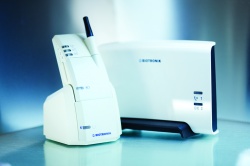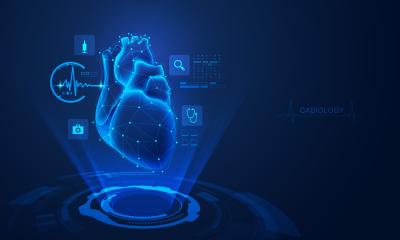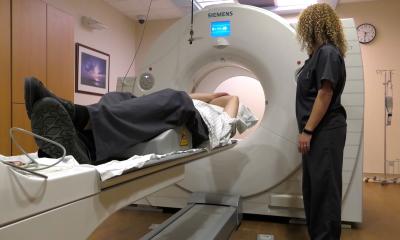Telecardiology
Home monitoring in fast action
Every year, worldwide, over a million patients have a pacemaker or defibrillator implanted. Home monitoring systems can significantly improve the safety and quality of life for these patients, says Professor Gerhard Hindricks, head physician in the rhythmology department at Leipzig’s Heart Centre.
Report: Sascha Keutel

Asked what technical and staff are needed by a cardiology department to introduce a home monitoring system, he explained that the technical prerequisites are given in every German hospital. These obviously include internet access and an acceptable bandwidth. However, he points out that the personnel infrastructure and workflow need more thorough consideration. ‘Who handles which data and how these data are then processed further must be clearly defined. In Leipzig, we have a specially trained staff-member who checks the data concerning their further processing and then forwards them to the respective staff.
‘Basically, you can say that the overall infrastructure in the hospital is significantly relieved by our cardiology Home Monitoring System and the treatment quality has improved significantly.’
‘Studies have shown a very positive effect on peoples‘ health through home monitoring. Our IN-TIME-study, for example, has shown a significant reduction in the overall mortality of cardiac degeneration patients through implant-based remote aftercare. We analysed whether the rate of cardiovascular mortality is reduced to the same extent as the overall mortality rate. It is indeed! One crucial driver of the reduction of the overall mortality rate is the reduction of the cardiovascular mortality rate.
‘There’s certainly also a psychological component. For the most part the patients accept home monitoring well. Only a few patients rejected our offer due to possible technology-based doubts they might have had. Most patients are happy that they now only have to plug in the CardioMessenger – an automatic transmitter similar to a mobile phone – into the power outlet. From this point on, transmission happens automatically. The patient thus has the certainty that the system immediately registers technical or medical abnormalities.’
Unsuitable patients
‘I cannot think of any condition at all under which home monitoring should not be used with a patient: there are no measurable risks. The system consumes only a little power, which does not influence the lifecycle of the implants at all. The patient also gets additional information from another partner in his existing health-network. This allows for significantly higher quality treatment at no additional cost.'
Cardiologist involvement
‘We’ve planned for interconnectedness with resident colleagues and have already implemented a system with some offices and have intensive exchange. We forward all relevant messages to these colleagues. However, the responsibility of informing the patients remains with us. For example, whenever we think a measure such as a change of the medicinal treatment is necessary, we consult with our colleagues and jointly develop a solution.'
Health insurance
‘We are currently negotiating with the health sector payers. They want to see data proving an improvement of quality before they take over financial responsibility. These data are now given. We made considerable input in setting up a high density of studies about home monitoring with the company Biotronik, in financing and processing it without asking too much from the health sector. Now I have an urgent request to all payers involved: Take a look at these data, take an acceptable position, and take responsibility for your patients. Turn the quality-improvement for the patients into financially relevant services!’
Documentation hopes
‘It’s not an inconsiderable task to successfully manage the connection of all data in a hospital. It would be an optimal approach and an efficient treatment-path if the data showing a decline in the patient’s health would automatically be transmitted through PACS or KIS into the medical record. This would ensure a direct connection, comprehensive documentation and follow-up treatment.
‘This connection is planned – but it has not yet been optimally implemented in all areas because it’s very complicated. No aspect of this, however, affects data security: all data are stored on a multiple-security platform allowing us encrypted access at any time, from any computer all over the world. It’s a matter of course that only authorised people have access to these data. The system is well protected!’
Communication and upkeep expenditure
‘The costs are currently carried by the manufacturers. The patient does not bear any additional cost. In addition, in case of downtimes, the data are of course not lost. We cooperate with cellular network providers who guarantee high network reliability. The transmission rate for Home Monitoring lies above 90%; this is very high.'
Future prospects
'Just like telemedical applications, these systems will play a vital role in disease management in the future. An ever-increasing amount of data regarding frequently occurring illnesses will be transmitted through automatic data systems. In the future, there will even be bio-monitors that will be adapted to the individual patient’s needs; also, in the mid-term, implants for which sensors are activated will be available. A dysrhythmia patient can then have an ECG-monitor activated; a diabetic with dysrhythmia will have an insulin or glucose sensor implanted and the ECG-monitor will also be activated for this patient. ‘This is how cardiology will look, in the future.’
PROFILE:
Cardiology and internal medicine specialist Gerhard Hindricks is a medical graduate of the Westfälische Wilhelms-University Münster, Germany. Today he co-directs the Cardiology and Angiology Department at the Heart Centre, University of Leipzig, where he has also been Professor of Medicine since 2005. The expert has contributed to more than 150 publications.
10.11.2015











